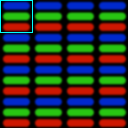|
|||||||||||||||||||||||||||||||||||||||||||||||||||||||||||||||||||||||||||||||||||||||||||||||||||||||||||||||||||||||||||||||||||||||||||||||||||||
Subpixel ZooA Catalog of Subpixel GeometryIntroduction and DefinitionsPixels are in-reality not magical little squares that have a color associated with them. For displays, the color needs to be represented by discrete "subpixel"s (usually but not always three: some kind of red, green, or blue). The perceived color is then the addition of the subpixels' emissions. Sensors in the photography and display world are made of little elements called "sensel"s or "photosite"s. These sensels may have color filters over them, limiting what wavelengths of light they respond to. As far as I can tell, an arrangements of sensels is called a "color filter array" (CFA), and when the arrangement is of red, green, and blue filters, the CFA is called a "Bayer filter" (pronounced [ˈba͡ɪ̯ˌəɹ]: BYE-er). This usage is sometimes inconsistent in the real-world, with non-Bayer CFAs erroneously being called Bayer. In some cases, CFA sensels are similar to subpixels: detecting the colors that will later be emitted. In other cases, demosaicing algorithms are used to reconstruct full color values over each sensel by using information from neighboring sensels. In this case, the sensels serve the function of (and are called) "pixel"s. When researching a given arrangement, it is usually difficult to determine which of the two options was intended. In this document, I'll use the display-centric "subpixel" terminology. Working in graphics (where knowing the particulars of such things is sometimes important) has brought my attention to the fact that there are a huge number of arrangements of subpixels and, shocked to find that there is no centrally located database of subpixels, I decided to categorize and name them myself. This page intends to exhaustively list all subpixel geometries that are used in-practice. They are drawn procedurally by the same program, with an outline describing each pixel (in some cases, multiple pixels must be outlined to show a tileable pattern). Click on any for a larger image. Relevant links and common products are also provided for some patterns. If you have verifiable evidence (e.g. a close-up picture) of a screen with a subpixel geometry not listed here, or spot an error, please contact me to let me know! You can also help contribute by adding new (or not implemented) geometries to the program. Square Geometries
Triangular GeometriesSome geometries cannot be described by square symmetry, and must be described by triangular symmetry. These were common for color cathode ray tube (CRT) displays, and have since made a resurgence in mobile device OLED displays. The most immediate concern is how the 2D square grid of the pixel data maps onto the non-square display. I haven't found anyone willing to say definitively what happens, but probably it's done by resampling, explicitly or implicitly—not by e.g. shifting alternate rows of the grid and squashing. Evidence in favor of this is the claim that CRT monitors are inherently multisync, and have no native resolution, as well as my own experiments on PenTile displays which showed that neighboring pixels can contribute to the same subpixel. Let's look at CRTs for an example. Color CRT displays work by sending three electron beams toward a triangular grid of holes. After the beams pass through a hole, they spread out slightly, to land on one of three phosphors (see diagram). It is tempting to think of these triangular clusters as "pixel"s, but in reality, as far as I can tell, the pixels still come from a rectangular scan of the beams. In particular, one image pixel might cover multiple, one, or less than one phosphor clusters—there is not a simple relationship between them. Each beam can only hit the correct color phosphor, but other than that, the difference between the rectangular image and the triangular subpixels is ignored (which we can interpret as resampling). Additional Credits
|
|||||||||||||||||||||||||||||||||||||||||||||||||||||||||||||||||||||||||||||||||||||||||||||||||||||||||||||||||||||||||||||||||||||||||||||||||||||
| |||||||||||||||||||||||||||||||||||||||||||||||||||||||||||||||||||||||||||||||||||||||||||||||||||||||||||||||||||||||||||||||||||||||||||||||||||||
































